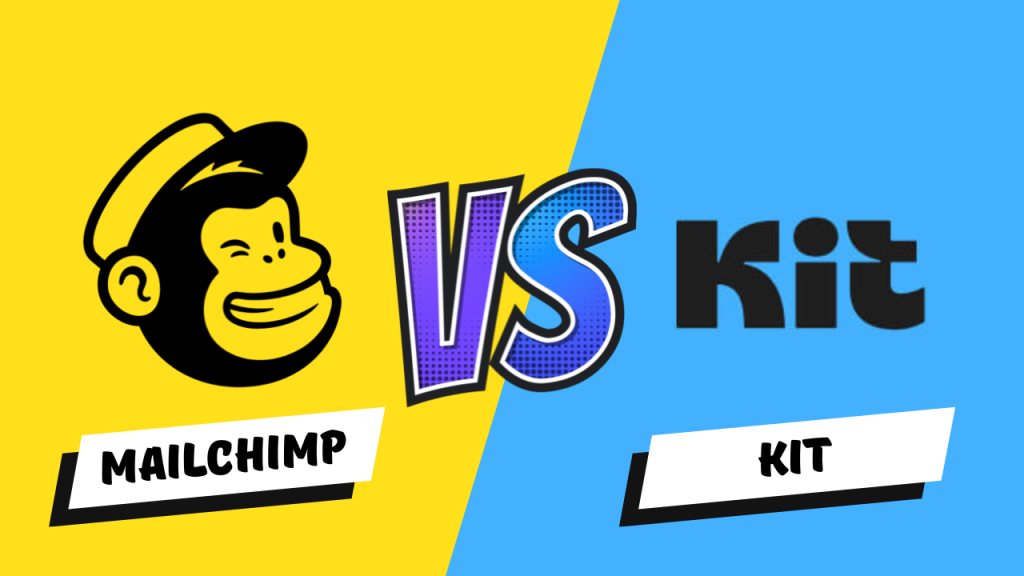Where Kit (formerly ConvertKit) vs Mailchimp split: Marketers want features, creators want simplicity. Perfect guide for bloggers, e-commerce brands, and digital product sellers.

Introduction
Feeling torn between Kit and Mailchimp? You’re not alone! With so many overlapping features, it’s easy to feel overwhelmed. But here’s the truth: the right platform depends entirely on your purpose. In this guide, we’ll compare Kit vs Mailchimp not just feature by feature, but by what you’re trying to accomplish from selling digital products to building a newsletter or running a marketing campaign. Let’s find the perfect fit for you!
Quick Overview — Kit (formerly ConvertKit) vs Mailchimp
- Mailchimp: A comprehensive marketing tool designed for businesses and agencies.
- Kit: A creator-focused platform built for bloggers, digital product sellers, and solopreneurs.
- Mailchimp offers more robust design and analytics features, while Kit focuses on simplicity and ease of monetization.
Best for Selling Digital Products
- Kit includes built-in commerce tools for selling digital products like ebooks, courses, or templates.
- Seamless Stripe integration and instant product delivery.
- Automation templates designed for product launches and sales sequences.
- Mailchimp requires third-party tools (e.g., Shopify or Gumroad) to sell digital goods.
Verdict: Kit is the better choice for creators selling digital goods.
Best for Content Creators & Bloggers
- Kit offers a clean visual automation builder with tagging and segmentation tailored for audience growth.
- Integrates natively with course platforms like Teachable and Podia.
- Focuses on email sequences, freebie delivery, and newsletter nurture funnels.
- Mailchimp offers broader marketing tools, but may feel too complex for solo creators.
Verdict: Kit (formerly ConvertKit) wins for bloggers and solo creators.
Best for E-commerce and Retail Brands
- Mailchimp has deep e-commerce integrations, especially with Shopify and WooCommerce.
- Built-in product recommendations, discount codes, and dynamic content blocks.
- Tracks revenue per campaign and provides e-commerce reports.
- Kit lacks advanced e-commerce features, focusing more on digital sales.
Verdict: Mailchimp is ideal for online stores and product brands.
Best for Agencies & Marketing Teams
- Mailchimp supports multiple user roles and client accounts.
- Offers robust analytics, campaign tracking, and content scheduling.
- Advanced segmentation and A/B testing.
- Kit (formerly ConvertKit) is best suited for individual creators, not teams.
Verdict: Mailchimp is better for teams and marketing professionals.
Best for Startups & Beginners
- Kit is incredibly beginner-friendly with a streamlined dashboard and intuitive setup.
- Mailchimp offers a generous free plan but a steeper learning curve.
- Choose based on your comfort with email tools and design preferences.
Verdict: Kit for ease of use, Mailchimp for broader design options.
Price Comparison by Use Case
- Kit allows up to 10,000 subscribers on the free plan. Great for startups.
- Mailchimp’s free plan includes 500 contacts and basic features.
- Paid plans vary in terms of automation and support, depending on your growth stage.
Pros & Cons Summary by Purpose
| Feature | Mailchimp | Kit |
|---|---|---|
| Free Plan Limit | Up to 500 contacts, up to 10,000 emails/month, includes basic builder & templates | Up to 10,000 subscribers free—includes unlimited landing pages, forms, tagging & segmentation |
| Automation & Funnels | Visual journey builder with automation templates, A/B tests, triggers & conditional logic | Visual automations with multiple entry points, conditional paths, and 6+ prebuilt templates |
| Number of Sales Funnels | No set limit. Unlimited journeys can be created as part of automation workflows | No hard limit. Built to support many funnels. Unlimited “visual automations” for any purpose |
| Integrations | 320+ native integrations (Shopify, WooCommerce, Zapier, social, etc.) | Extensive ecosystem with Teachable, Podia, Quiz tools (ScoreApp), API, Zapier |
| Contact Management | List-centric model. Charges for duplicates across lists; segmentation via lists and tags | Subscriber-centric. One “master list” with tagging avoids duplicates |
| E-commerce & Digital Products | E-commerce features with product blocks, recommendations, postal campaigns, and CRM basics | Built-in checkout for digital products via Stripe, plus commerce support and creator tools |
| Reporting & Analytics | AI-powered insights, campaign comparison, advanced segmentation, e-commerce metrics | Simple yet effective reporting—focus on open rates, subscriber activity; less data-intensive |
| Ease of Use | Rich, feature-heavy interface with moderate complexity | Clean, intuitive, creator-friendly—praised for simple onboarding and clear workflows |
Conclusion
Choosing between Kit and Mailchimp becomes simple when you align it with your goal. Whether you’re selling digital products, building a loyal readership, or running a full-scale e-commerce brand, the right choice is the one that supports your mission. Try both for free and see which one clicks!